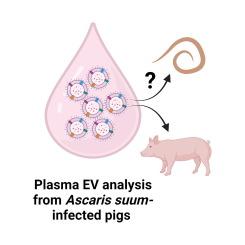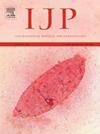Micro RNA profiles of host extracellular vesicles are modulated by Ascaris suum infection but parasite extracellular vesicle miRNAs are systemically undetectable using in-depth miRNA sequencing
IF 3.7
2区 医学
Q1 PARASITOLOGY
引用次数: 0
Abstract
The intestinal helminth Ascaris lumbricoides infects over 800 million people. Infections are often chronic and immunity is not sterilizing due to host-immune modulation, therefore reinfection is common after antihelmintic treatment. We have previously demonstrated a role for Ascaris spp. extracellular vesicles (EVs) in host immune modulation but whether EVs are recognized by the adaptive immune system and are present systemically in the host remains unknown. Therefore, we employed a well-established trickle infection model in pigs to mimic natural Ascaris infection in humans. EVs were isolated from adult Ascaris suum followed by immunoblotting of EV and EV-depleted secretory fractions using plasma from infected and uninfected pigs. Next, EVs were isolated from pig plasma at day 56 post first infection and subjected to deep small RNAseq analysis. RNAs were aligned to A. suum and Sus scrofa miRNA complements to detect A. suum EVs and elucidate the host EV micro RNA (miRNA) response to infection, respectively. Infection generates robust antibody responses against A. suum EVs that is distinct from EV-depleted fractions. However, A. suum miRNAs were not detectable in EVs from the peripheral blood. Notably, host plasma-derived EV miRNA profiles showed significant changes between infected and uninfected pigs, indicating that Ascaris infection drives systemic changes in host EV composition.

宿主细胞外囊泡的微RNA谱受蛔虫感染的影响,但寄生虫细胞外囊泡的miRNA在深度miRNA测序中是系统检测不到的。
肠道蠕虫蛔虫感染了 8 亿多人。感染通常是慢性的,由于宿主免疫调节作用,免疫不能杀菌,因此抗蠕虫药治疗后再感染很常见。我们之前已经证明了蛔虫胞外囊泡(EVs)在宿主免疫调节中的作用,但EVs是否能被适应性免疫系统识别并系统地存在于宿主体内仍是未知数。因此,我们采用了一种成熟的猪涓流感染模型来模拟人类的自然蛔虫感染。从成年蛔虫体内分离出 EVs,然后用感染猪和未感染猪的血浆对 EV 和 EV 贫化分泌物部分进行免疫印迹。然后,从首次感染后第 56 天的猪血浆中分离出 EVs,并对其进行深度小 RNAseq 分析。将 RNA 与 A. suum 和 Sus scrofa miRNA 互补序列进行比对,分别检测 A. suum EVs 和阐明宿主 EV 微 RNA(miRNA)对感染的反应。感染会产生针对鼠EVs的强抗体反应,这种反应与EV去除了的部分不同。然而,在外周血的EVs中检测不到鼠疫miRNA。值得注意的是,宿主血浆来源的 EV miRNA 图谱在感染猪和未感染猪之间发生了显著变化,这表明蛔虫感染驱动了宿主 EV 组成的系统性变化。
本文章由计算机程序翻译,如有差异,请以英文原文为准。
求助全文
约1分钟内获得全文
求助全文
来源期刊
CiteScore
8.40
自引率
2.50%
发文量
76
审稿时长
23 days
期刊介绍:
International Journal for Parasitology offers authors the option to sponsor nonsubscriber access to their articles on Elsevier electronic publishing platforms. For more information please view our Sponsored Articles page. The International Journal for Parasitology publishes the results of original research in all aspects of basic and applied parasitology, including all the fields covered by its Specialist Editors, and ranging from parasites and host-parasite relationships of intrinsic biological interest to those of social and economic importance in human and veterinary medicine and agriculture.

 求助内容:
求助内容: 应助结果提醒方式:
应助结果提醒方式:


